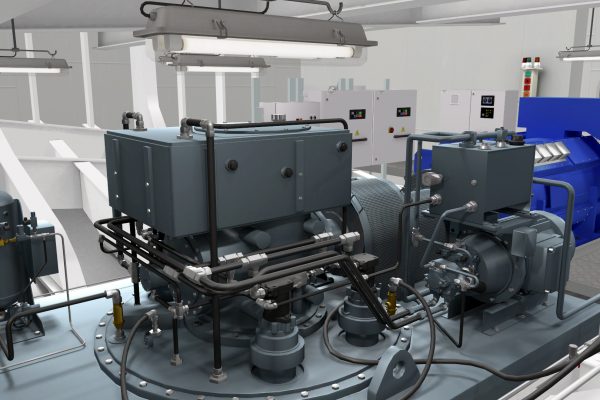
UNITEST LNG DE3D Simulator Introduction
The UNITEST LNG DE3D Engine Room Simulator has been based on engine room equipped with diesel electric dual fuel propulsion system powered by Liquefied Natural Gas and Diesel Oil. This type of propulsion is widely used in modern propulsion system on various types of vessels. The following simulator has been based on a Ferry vessel which is used for carrying vehicles and passengers. Generally, the propulsion system includes three (3) DF Diesel Generators 3×1489 kW and two (2) Azimuth Thrusters 2×1750 kW.
The simulator is designated for training all Marine Engineers, students of maritime academies as well as for different types of marine vocational training centres. The simulator has universal features and gives a realistic experience in ship environment.
Model description
The simulator includes an Integrated Automation System which fully integrates all significant data into a single platform. The IAS allows the operator to go through LNG bunkering process. The Power Management System contains all the standard functions, such as load dependant start/stop, load sharing, synchronising, and load shedding. The Alarm and Monitoring System allows the operator to control all propulsion system equipment parameters. Emergency operating procedures can be trained by fault simulation and scenario editor mode.
The main purpose of the simulator is the practical preparation of the trainee for engine room operation, and more particularly:
- LNG bunkering and Diesel Generator/ Boiler supply process;
- familiarization with the engine room installation (electric power plant system, compressed air system, fresh and sea water cooling system, lubricating and fuel oil system);
- acknowledgment with diesel generators, thrusters and auxiliary equipment starting procedure;
- propulsion system manoeuvring;
- power management system operation PMS.
Plants overview
All operations in UNITEST LNG DE3D simulator can be done in specific system installation and compartments. Each system is presented as a real vessel’s schematic drawings/compartment with ability to control on screen. The most important components of the scheme can be zoomed and sent to a proper location in Engine Room to operate.
UNITEST LNG3D main features:
- The operator has the possibility to go through LNG bunkering and supply process, choose between different LNG filling options for the tank (top filling, bottom filling, top and bottom, auto pressure control filling). The following procedures can be trained: INERTING OF GAS/VAPOUR RETURN HOSE, INERTING AND PRECOOLING OF LNG HOSE, HOSE LEAKAGAE TEST and ESD Valve test.Most of the control of LNG bunkering valves is done through automatic control sequences, the operator has the opportunity to go through all the procedures in manual mode.
- The user interface includes virtual controls and alarms that create a very realistic environment. The 3D virtual reality with active valves, tank level indicators and selected digital gauges enables comfortable engine room operation and monitoring. Zoom function allows for navigation in 3D environment and easy access to details.
- Multichannel digitized sound provides a very realistic engine room feel. The sound effects include: engine sound correlated with engine speed, the sound of a diesel generator starting and running sound, alarm and machine telegraph buzzers. Emergency procedure training includes fire simulations.
- Operations related to drivers subsystems including valves operations and all auxiliary equipment (pumps, coolers, filtration units, etc.).
- Drives operations from the following stations:- Control from bridge: Navigation bridge console panels allow for operating propulsion plant.
– Engine Control Room: Water mist system, Fire station and ESD buttons, Control of propulsion plant.
– Local Control of Engine Room equipment: Diesel Generator Local Operation Panels.
– Starting and Control air compressors, Fuel filters, Electric motors and Fan starters, Boiler and more. - Learning engine room typical operating routines.
- Engine room operation training. The user will have the possibility to accomplish any operational task starting from different set-ups, both pre-prepared and saved by the user.
- Corrective action learning when faults occur. Different faults can be simulated and mixed in the run-time or loaded from disk.
Technical specification
Diesel Generator: Dual Fuel, 4-stroke, non-reversible, turbocharged and intercooled diesel engine with direct injection of fuel, 3x 1480 kW.
Propulsion Type: Azimuth Thrusters 2×1750 kW, nominal speed 247 rpm.
Power transmission system: Azimuth Thruster Electric motor type 2x570V, nominal power 2x1800kW, nominal speed 1200 rpm.
Vessel’s particulars:
Length overall: 107,2 m
Breadth moulded: 23,5 m
Draught: 4,65 m
Tonnage: 8261 gt
Speed: 15 knots
Capacity:
Passengers: 584
Crew: 16
Cars: 150
To meet the requirements:
Engine Room Simulator has been developed to comply with STCW Code:
- Section A-1/12 and Section B-1/12
- ISM Code: Section 6 and Section 8


























